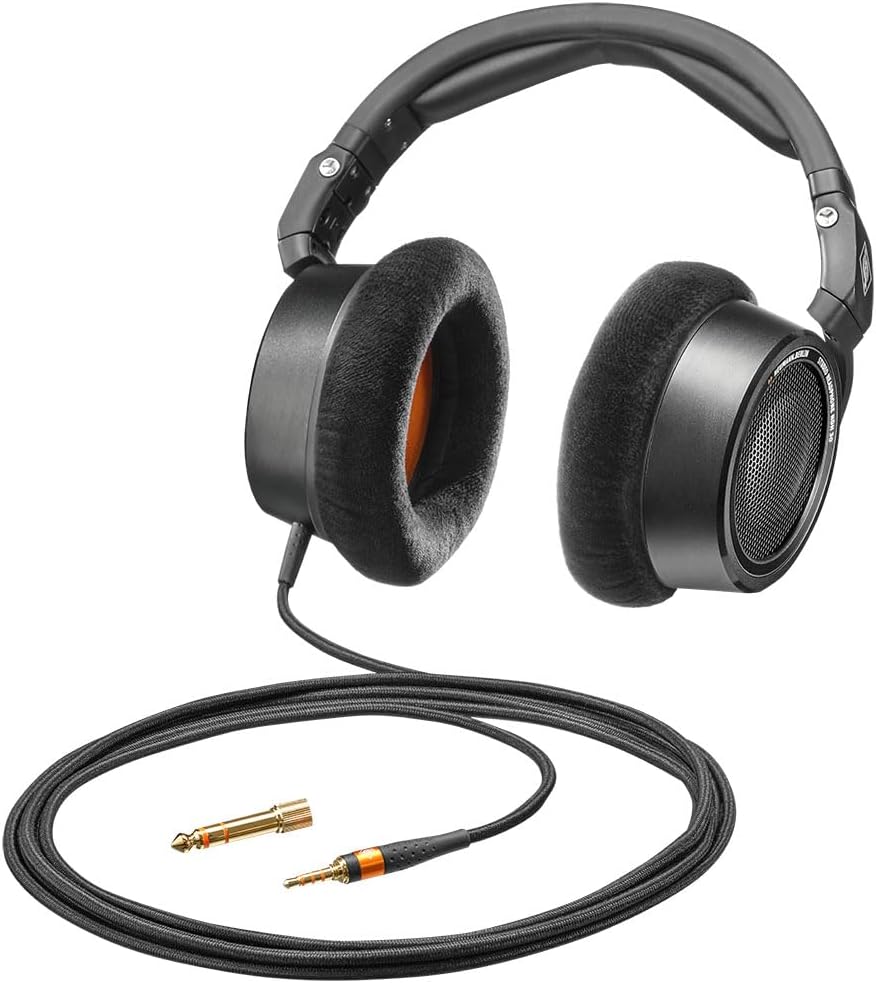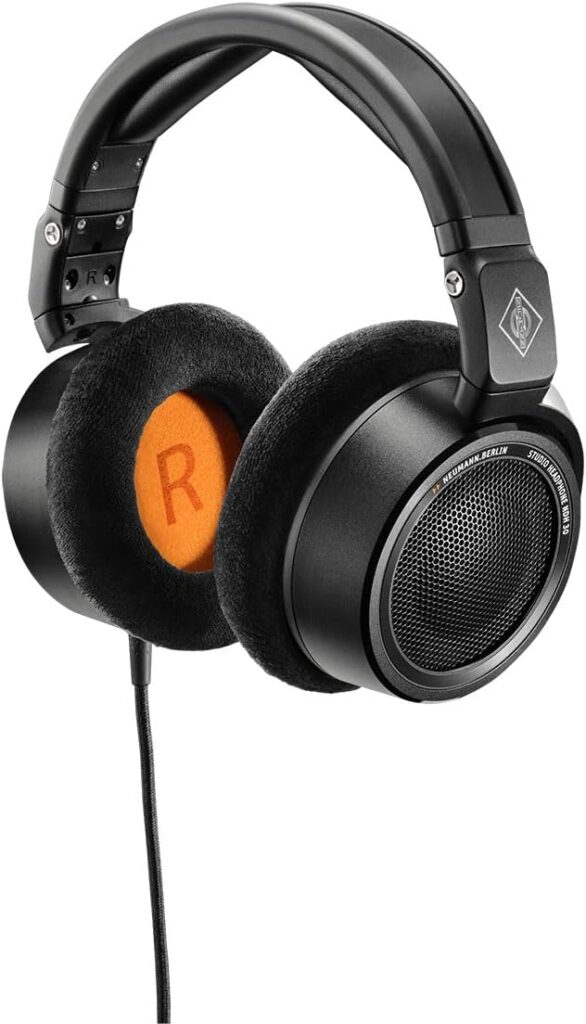Neumann NDH 30 Review
When Neumann, a name synonymous with high-end studio microphones for nearly a century, ventured into the headphone market, it was a move that piqued the interest of audio professionals and enthusiasts alike. Their first offering, the closed-back NDH 20, debuted in 2019 and set a high bar for studio-grade headphones. Fast forward to 2022, and Neumann introduced the NDH 30, an open-back counterpart designed to deliver reference-quality sound in a portable form. In this review, we will explore the Neumann NDH 30 in depth—its design, build quality, sound performance, and practical applications—while assessing whether it lives up to the legacy of its predecessor and the brand’s storied reputation.
Neumann NDH 30 Review
The Neumann NDH 30 is marketed as a tool for audio professionals, particularly those involved in mixing, mastering, and editing, though its appeal extends to audiophiles seeking a neutral listening experience. Unlike the NDH 20, which prioritizes isolation for tracking and monitoring in noisy environments, the NDH 30 embraces an open-back design to provide a more natural soundstage and accurate reproduction of audio. Neumann’s stated goal with the NDH 30 is ambitious: to replicate the reference sound of their KH-line studio monitors, calibrated via the MA 1 alignment system, in a headphone format that’s portable and versatile. This makes it a compelling option for professionals who need consistency between headphone and speaker-based workflows, as well as for those working in varied environments.
Priced around $650 USD, the NDH 30 sits in a competitive segment of the market, going head-to-head with established players like the Beyerdynamic DT 1990 Pro, Sennheiser HD 650, and Austrian Audio Hi-X65. But does it deliver enough to justify its cost and stand out in this crowded field? Let’s break it down.
Design and Build Quality
Aesthetics and Construction
At first glance, the NDH 30 bears a striking resemblance to its closed-back sibling, the NDH 20. The headphones feature a utilitarian, no-nonsense design with a silver and black color scheme that exudes professionalism rather than flashiness. The earcups are crafted from lightweight aluminum, while the headband is made of flexible spring steel, ensuring durability without excessive weight. Weighing in at 352 grams (without the cable), the NDH 30 is on the heavier side for open-back headphones, but the robust construction suggests it’s built to withstand the rigors of studio use.
The open-back design is immediately apparent in the perforated earcups, which contrast with the solid metal plates of the NDH 20. This change not only affects the sound but also gives the NDH 30 a slightly more airy and less imposing appearance. The earpads are covered in a soft, velour-like fabric, a departure from the tighter velvet of the NDH 20, and are paired with memory foam for comfort. These pads are replaceable, as is the detachable cable—a practical touch for long-term maintenance.
The cable itself is a 3-meter (9.8-foot) straight, cloth-covered design with a 3.5mm termination and a 6.3mm adapter included. It connects to the right earcup via a locking mechanism, which is a thoughtful detail for secure use, though the right-side entry might feel unconventional for users accustomed to left-side cables on other studio headphones. While the length is ideal for studio settings, some users might wish for a shorter option for portability, which was included with the NDH 20 but omitted here.
Comfort and Ergonomics
Comfort is a critical factor for headphones intended for long mixing or listening sessions, and the NDH 30 delivers a mixed bag. The velour earpads are soft and spacious, with an inner diameter of approximately 65mm and a depth ranging from 22mm to 27mm, accommodating most ear sizes without pressing against them. The clamping force is moderate—firm enough to feel secure but not so tight as to cause fatigue quickly. At 352 grams, the weight is noticeable, but the design distributes it reasonably well across the head.
The headband, however, is a point of contention. While padded with plush foam, its narrow width concentrates the headphone’s weight on a small area of the scalp, which can lead to discomfort after extended use. Some users report redness or mild pain after 30 minutes to an hour, suggesting that a wider, flatter cushion could improve long-term comfort. For comparison, competitors like the Sennheiser HD 650 use a broader suspension strap that mitigates this issue more effectively.
The foldable design is a welcome feature, allowing the NDH 30 to collapse into a compact form for storage or travel, though the included cloth pouch offers minimal protection against knocks. Overall, the build quality is exceptional—sturdily constructed with premium materials—but comfort could be a limiting factor for some users during prolonged sessions.
Sound Quality
Technical Specifications
The NDH 30 is equipped with 38mm dynamic drivers featuring high-gauss neodymium magnets, delivering a frequency response of 12 Hz to 34 kHz. With an impedance of 120 ohms and a sensitivity of 104 dB SPL (1 kHz/1V RMS), these headphones are relatively easy to drive compared to higher-impedance models like the Sennheiser HD 650 (300 ohms). While they can function without an amplifier when paired with a decent audio source, they scale well with dedicated headphone amps or audio interfaces, unlocking their full potential.
The open-back design inherently sacrifices isolation—sound leaks out, and ambient noise seeps in—but this trade-off enhances the soundstage and transient response, aligning with Neumann’s goal of monitor-like accuracy. Total harmonic distortion (THD) is impressively low at less than 0.03% (1 kHz, 100 dB SPL), a significant improvement over the NDH 20’s already commendable 0.1%, promising clean, uncolored audio reproduction.
Frequency Response and Tonality
The NDH 30’s sound signature is deliberately neutral, prioritizing accuracy over excitement. This isn’t a headphone that wows with exaggerated bass or sparkling treble; instead, it aims to present audio as it was recorded, making it a true reference tool.
- Bass: The low end is articulate and controlled, extending down to 12 Hz with a dry, unembellished character. There’s a slight boost in the 100-150 Hz range, adding subtle warmth, but it never overwhelms or muddies the mix. Compared to planar magnetic headphones like the HiFiMAN Sundara, the sub-bass lacks the earth-shaking impact, but it’s precise and well-defined—ideal for discerning kick drums and basslines in dense mixes.
- Midrange: The mids are the star of the show, offering lush, even reproduction without the scooped or forward tendencies found in many consumer headphones. Vocal sibilance and instrumental detail are presented matter-of-factly, avoiding artificial brightness or resonance. This clarity makes the NDH 30 an excellent choice for critical listening and mix adjustments.
- Treble: The high frequencies are transparent but restrained, rolling off slightly above 10 kHz. This avoids harshness or fatigue, but some listeners might find it lacks the “air” or sparkle of competitors like the Beyerdynamic DT 1990 Pro. Neumann employs frequency-selective absorbers to tame exaggerated highs, ensuring a smooth, non-fatiguing experience that prioritizes accuracy over embellishment.
Soundstage and Imaging
As an open-back headphone, the NDH 30 excels in soundstage width and imaging precision. The angled drivers mimic the directionality of studio monitors, creating a spacious, three-dimensional presentation that rivals the best in its class. Instruments are placed with razor-sharp accuracy, and the stereo panorama feels natural rather than artificially wide. While not as “airy” as some audiophile-grade open-backs (e.g., Sennheiser HD 800 S), the NDH 30’s soundstage is more intimate and monitor-like, aligning with its professional focus.
Dynamics and Detail
The NDH 30’s transient response is lightning-fast, thanks to the open-back design and low-distortion drivers. This speed translates to exceptional detail resolution—every nuance, from subtle reverb tails to faint percussion hits, is laid bare. However, some critics note a lack of dynamic “punch” or “bite,” describing the sound as informative but not emotionally engaging. This restraint is intentional, reflecting its purpose as a mixing tool rather than a hi-fi entertainment device, though it may disappoint listeners seeking a more visceral experience.
Practical Applications
Studio Use
For mixing and mastering, the NDH 30 shines. Its neutral frequency response and detailed imaging allow engineers to make precise EQ and spatial decisions with confidence. The compatibility with Neumann’s KH-line monitors (when calibrated via MA 1) ensures tonal consistency across workflows, a rare and valuable feature. However, the open-back design precludes its use for tracking or monitoring in live settings, where bleed would interfere with microphones—a role better suited to the NDH 20.
Audiophile Listening
While designed for pros, the NDH 30 holds its own for critical listening. Its balanced sound reveals intricacies in well-recorded tracks, though its lack of hype might underwhelm those accustomed to consumer-oriented headphones with boosted bass or treble. For genres like classical or jazz, where fidelity and spatial accuracy matter most, it’s a delight.
Portability and Versatility
The foldable design and detachable cable enhance portability, but the lack of a shorter cable option and the flimsy cloth pouch limit its practicality on the go. At 120 ohms, it’s drivable by smartphones or laptops, though a proper amp elevates the experience significantly.
Comparisons
- Sennheiser HD 650: A benchmark for open-back headphones, the HD 650 offers a warmer, more musical sound with a broader headband for comfort. The NDH 30 counters with superior detail and a flatter response, though it’s less forgiving and comfortable over time.
- Beyerdynamic DT 1990 Pro: The DT 1990 Pro delivers brighter treble and punchier dynamics, appealing to those who prefer an analytical edge. The NDH 30 is smoother and less fatiguing, with better midrange clarity.
- Neumann NDH 20: The closed-back NDH 20 isolates better and suits tracking, while the NDH 30’s open design provides a wider soundstage and more natural resonance. Both share a linear ethos, but the NDH 30 feels more refined.
Pros and Cons
Pros
- Exceptional detail resolution and imaging
- Neutral, monitor-like sound signature
- Robust build quality with replaceable parts
- Foldable design for portability
- Low distortion and fast transient response
Cons
- Headband comfort issues for long sessions
- Limited sound isolation due to open-back design
- Treble roll-off may lack “air” for some
- No short cable option included
- Premium price point
Conclusion
The Neumann NDH 30 is a triumph of engineering, delivering on its promise of reference-quality sound in a portable package. Its neutral tonality, precise imaging, and compatibility with Neumann’s monitor ecosystem make it an invaluable tool for audio professionals, particularly those focused on mixing and mastering. The build quality is top-notch, reflecting the brand’s heritage, and the open-back design unlocks a level of spatial accuracy that the NDH 20 couldn’t achieve.
However, it’s not without flaws. The headband’s narrow padding hampers comfort during extended use, and the restrained dynamics might leave some listeners wanting more excitement. At $650, it faces stiff competition from established rivals that offer similar performance with different strengths—whether it’s the HD 650’s warmth or the DT 1990 Pro’s analytical edge.
Ultimately, the NDH 30 is best suited for those who prioritize accuracy and detail above all else, whether in the studio or at home. It’s not a headphone that screams for attention; rather, it quietly proves its worth with every listen. For audio engineers seeking a reliable reference or audiophiles craving uncolored sound, the Neumann NDH 30 deserves a spot on the shortlist—just be sure to audition it first to ensure it fits your head and your sonic expectations.



